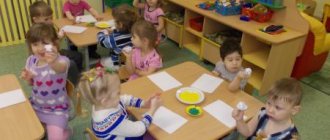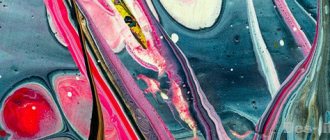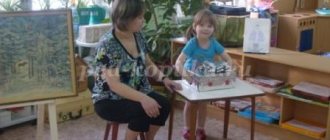What are the benefits of using non-traditional techniques?
This is interesting. From an early age, children try to reflect their impressions of the world around them in visual activities through the visualization of sensations. Hence the desire to draw with fingers on foggy glass, with a stick on the sand and with chalk on the asphalt.
So, existing non-traditional drawing techniques have the main advantage - they allow you to quickly see the results of your work. And, really, putting a blot on paper with your own finger and seeing a funny design in it is fast and fun. In addition, unusual techniques allow
- develop creative abilities;
- form a non-trivial view of the world around you;
- help develop imagination and creativity;
- develop fine motor skills;
- cultivate independence.
Non-traditional techniques of visual activity in the second junior group
Publications on the topic:
Parent meeting in the second junior group “Games with colors. Non-traditional drawing techniques in kindergarten" "Games with paints! Non-traditional drawing techniques in kindergarten." Parents' meeting in the second junior group. Purpose: Show parents.
Non-traditional techniques of visual activity. Tree made of buttons Three-year-old children still do not hold a brush well, and not all children have shown interest in visual arts. Get kids interested in art.
Notes on visual activities in the second junior group “Meeting with the cheerful Kolobok” Notes on a lesson on visual arts using non-traditional drawing techniques in the second junior group. Topic: » Meeting.
Lesson notes on visual arts. Unconventional drawing techniques. Foam imprint. Drawing a penguin Summary of educational activities for visual activities in a mixed-age group. TOPIC: “Unconventional drawing techniques. Foam imprint. Drawing.
Master class for parents “Salt. Non-traditional techniques of visual activity in the work of a teacher-psychologist” Master class on the use of non-traditional techniques of visual activity in the work of a teacher-psychologist on anxiety prevention and development.
Master class on visual arts for teachers “Non-traditional drawing techniques” Appendix 4 MASTER – CLASS on visual arts for teachers (Part I) “Non-traditional drawing techniques” Relevance of the chosen one.
Presentation “Development of creative abilities of preschoolers through non-traditional techniques of visual activity” “Development of creative abilities of preschoolers through non-traditional techniques of visual activity” Performed by: Levitskaya Galina Nikolaevna, MDOU.
Project “Development of fine motor skills of hands through non-traditional techniques of visual activity. Zimushka winter" PROJECT "Development of fine motor skills of hands through non-traditional techniques of visual activity" Topic: "Winter winter" Prepared by: Evtushevskaya.
Video lesson on visual arts in the second junior group In a lesson on visual arts in the second junior group, educational and developmental tasks: - mastering the action of substitution.
Lesson "Applique". Non-traditional techniques of visual activity in the middle group Topic: “Friends of the snowman” Goal: to develop the ability to create the image of a snowman using non-traditional techniques of visual activity.
Scheme for drawing up lesson notes
This work must begin with the formulation of goals and objectives through visual activity. As for the goals, to those that were identified in the context of non-traditional drawing techniques in general, we can add some specific ones:
- practice the ability to recognize and name colors;
- introduce children to different types of drawing materials (gouache, watercolor, etc.);
- cultivate accuracy and goodwill in group and individual work.
During drawing classes using non-traditional techniques, the following educational tasks are solved:
- children learn to work with signets, soap bubbles, cotton swabs, and also learn to draw with their fingers or palms;
- an idea of paint concentration and basic skills in creating shades are formed;
- expressive images are created, while maintaining the liveliness and spontaneity of the child’s worldview;
- the joy of receiving a product of one’s own creativity is fostered.
The success of the lesson also depends on how carefully the teacher distributes time between all stages of work. As you know, a lesson in kindergarten lasts 30 minutes, during which you need to go through 3 stages of work:
- introduction (about 5 minutes) – implementation of motivational techniques (conversation on a topic, playing with visuals, role-playing, reading poems, listening to songs, etc.);
- the main part (about 20 minutes) is to complete the drawing;
- conclusion (about 5 minutes) - summing up, praise of the teacher, reflection of the kids (in the form of answers to questions - “Did you like drawing in such an unusual way?”, “Do you think you succeeded?”, “Whose work do you think is the most beautiful ? etc.).
Whatever technique you choose, children must be helped to realize their intended image.
Please note that some techniques (such as signet painting) do not require much time to complete. In this case, you can increase the timing of the introductory part using dramatization, role-playing, that is, techniques that require a lot of time.
Summary of GCD for drawing in the younger group using non-traditional drawing techniques
Direct educational activities in the younger group (3-4 years old).
Abstract. Author: Marina Viktorovna Kozachenko, teacher Place of work: MKDOU “Kindergarten No. 4”, Korenevo village, Kursk region
Summary of a drawing lesson in the second junior group using non-traditional drawing techniques.
Description of work: a summary of educational activities on visual arts (drawing) using non-traditional drawing techniques - finger and palm drawing, will be of interest to educators and parents of children 3 - 4 years old. Finger painting is very popular with kids and has a beneficial effect on the development of the child. Theme: Multi-colored carpet.
Goal: Continue teaching children to draw grass with their entire palm using the dipping technique. Reinforce knowledge of the 4 primary colors (green, red, yellow, blue). Improve the ability to draw any lines from a blot with your fingers (blotography). To develop creative qualities in preschoolers. Arouse interest in drawing and a sense of satisfaction from the work. Integration of educational areas: “cognitive development”, “speech development”, “physical development”, “artistic and aesthetic development”, “social and communicative development”. Materials and equipment: finger paints of 4 colors, plates with green paint, a strip of paper (0.5/3 m), a basin with warm water, wet wipes, a toy cockerel, a house for a cockerel, a damaged rug, gram. recording "Waltz of the Flowers". Progress of the lesson: Educator: Come on in, guys, don’t be shy, make yourself comfortable. Make friends with your legs, put your hands down. Get your ears ready, get your eyes ready, I’ll tell you a fairy tale now... (to the accompaniment of Russian folk music, the teacher tells a fairy tale) Educator: At the edge of the forest, in a small hut, there lived a cockerel and his chickens. One day, mice snuck into the hut where the cockerel and chickens lived. Even during the day they walked around the house and gnawed everything they came across. And then a disaster happened: the mice gnawed through the rug on which the chickens always played. The rug was very beautiful, like a spring lawn. It depicted grass and beautiful flowers. The chickens loved this rug! (showing a damaged rug) Educator: Guys, do you want the cockerel from this fairy tale to come to us? (children's answers) Let's remember the Russian folk nursery rhyme about a cockerel. Reading a nursery rhyme There is a cockerel, a red comb, a tail with patterns, boots with spurs, a double beard, a quick gait, he gets up early in the morning, he sings red songs. (The teacher takes the cockerel out of the house) Teacher: Guys, look, the cockerel brought paints and asks you to help - draw a new beautiful rug for his chickens. Shall we help our guest? (children's answers) Educator : Oh, kids, the cockerel forgot to bring his brushes! But it's okay, we can handle this task because we have handles. Psycho-gymnastics Show me your hands, stretch them forward, close your eyes and I will make your hands magical. (the teacher strokes the hands of each child) Open your eyes, your hands have turned into magic and now we don’t need brushes - we will paint with our palms and fingers. Let's show with me how our fingers draw in the air. (Kids repeat after the teacher movements that imitate drawing a variety of lines: up, down, right, left). The tables are arranged in three rows. A strip of paper (0.5/3 m) is fixed on the middle row. 1 and 3 each have 5 plates with green paint. Separately prepared: wet wipes, basins with warm water and towels. The teacher brings the children to the middle row and places them on both sides (opposite each other). Educator: Children, first we will draw grass. What color will we paint the grass? (children's answers) Educator: You need to go to the plate with paint, dip one palm into the paint, then the other. We return to our seats and press our palms to the paper. (Show the teacher on a separate sheet).
Sounds like gram. recording "Waltz of the Flowers". Doing work by children. Children sit at the tables and get to work. After drawing the grass, the children wash their hands. Finger gymnastics (preparing children for finger painting) Into the forest by the berries One, two, three, four, five (the fingers of both hands “hello” - touch each other: first connect the thumbs, then the index fingers, etc.), B We’re going for a walk in the forest (the index and middle fingers of both hands “walk” along the table). For blueberries, for raspberries (with the index finger of your right hand, bend the fingers on your left, starting with the thumb), for lingonberries and for viburnum. We will find strawberries and take them to our brother. (the index and middle fingers of both hands “walk” along the table) Children return to their places at the tables. Educator: Now we will draw flowers on the rug. The flowers will be colorful and very beautiful. And we will draw them using a drawing technique - blotography, the word means a drawing from a blot. We are already familiar with this drawing technique. Let me remind you. (Three pipettes contain paint: yellow, red, blue) The teacher shows on a separate sheet the technique of drawing from a blot, drawing straight lines from the blot with his finger.
Doing work by children. Each child has 3 blots of different colors, children draw flowers. Educator: What colors of paints do you use to paint flowers? At the end of their work, children wipe their hands with wet wipes and return to the tables.
Educator: Do you like the rug you drew? And the cockerel really likes it, but he wants to know what colors of paint you used? (children's answers) Children fix the primary colors. Educator: The cockerel thanks you, now his chickens will play on a beautiful rug again. And the chickens gave you “Colored Peas” candies in gratitude. What color is the candy? (children's answers) Educator: Well done! You did a great job! When our mat is dry, we will roll it up and give it to the cockerel, and he will give the mat to his chickens.
We recommend watching:
Drawing with palms and fingers in kindergarten for children of the middle - senior group. Notes on drawing in the second junior group. Notes on drawing in the junior group. Notes on drawing with elements of application in the younger group on the topic: Space.
Similar articles:
Master class for preschool teachers. Unconventional drawing techniques
"Wet" drawing technique
Parents about non-traditional drawing techniques
Application with drawing elements
Non-traditional drawing techniques in kindergarten for children 5-6-7 years old



